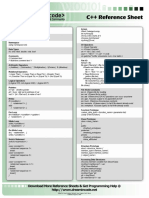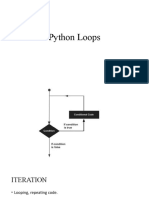IntroCS Part 7
Uploaded by
Alfred FredIntroCS Part 7
Uploaded by
Alfred Fred60
Program 2.2.8
Gambler simulation
public class Gambler
{
public static void main(String[] args)
{
int stake = Integer.parseInt(args[0]);
int goal = Integer.parseInt(args[1]);
int N
= Integer.parseInt(args[2]);
int bets = 0, wins = 0;
for (int i = 0; i < N; i++)
{ int t;
for (t = stake; t > 0 && t < goal; bets++)
if (Math.random() > 0.5)
t++;
else t--;
if (t == goal) wins++;
}
System.out.println(100*wins/N + % wins);
System.out.println(Avg # bets: + bets/N);
}
}
The inner for loop in this program
simulates a gambler with $ stake
who makes a series of $1 bets, continuing until going broke or reaching
$goal.
% javac Gambler.java
% java Gambler 10 20 1000
50% wins
Avg # bets: 100
% java Gambler 50 250 100
19% wins
Avg # bets: 11050
a series of fair $1 bets, starting with some given initial stake. The gambler
always goes broke, eventually, but when we set other limits on the game, various questions arise. For example, suppose that the gambler decides ahead of
time that she will walk away after reaching a certain goal. What are the
chances that she will win, and how many bets might she have to make before
winning or losing the game?
Class Gambler in Program 2.2.8 is a simulation that can help answer
these questions. It does a sequence of trials, using Math.random to simulate
the sequence of bets, continuing until the gambler is broke or the goal
An Introduction to Computer Science
Conditionals and Loops
reached, and keeping track of the number of wins and the number of bets.
After running the experiment for the specified number of trials, it averages
and prints out the results. You might wish to run this program for various
values of the command-line arguments, not necessarily just to plan your next
trip to the casino, but to help you think about the following questions: Is the
simulation an accurate reflection of what would happen in real life? How
many trials are needed to get an accurate answer? What are the computational
limits on performing such a simulation? Simulations are widely used in applications in economics, science, and engineeering, and questions of this sort
are important in any simulation.
In the case of Program 2.2.8, we are merely verifying classical results
from probablity theory, which say the the probability of success is the ratio of
the stake to the goal and that the expected number of bets is the product of
the stake and the desired gain (the difference between the goal and the stake).
For example, if you want to go to Monte Carlo to try to turn $500 into $2500,
you have a reasonable (20%) chance of success, but you should expect to
make a million $1 bets!
Simulation and analysis go hand-in-hand, each validating the other.
In practice, the value of simulation is that it can suggest answers to questions
that might be too difficult to resolve with analysis. For example, suppose that
our gambler, recognizing that she will never have the time to make a million
bets, decides ahead of time to set an upper limit on the number of bets. How
much money can she expect to take home in that case? You can address this
question with an easy change to Program 2.2.8 (see Exercise 2.2.25), but
addressing it with analysis is likely to be beyond your reach.
61
62
Program 2.2.9
Factoring integers
public class Factors
{
public static void main(String[] args)
{
long N = Long.parseLong(args[0]);
for (long i = 2; i <= N/i; i++)
while (N % i == 0)
{ N /= i; System.out.print(i + ); }
if (N > 1) System.out.println(N);
}
}
This program prints the prime factorization of any positive integer in Javas
long data type. The code is simple,
but it takes some thought to convince
oneself that it is correct (see text).
% javac Factors.java
% java Factors 3757208
2 2 2 7 13 13 397
% java Factors 287994837222311
17 1739347 9739789
Factoring. Class Factors in Program 2.2.9 computes the prime factorization
of any given positive integer. In contrast to many of the other programs that
we have seen (which we could do in a few minutes with a calculator or even a
pencil and paper), this computation would not be feasible without a computer. How would you go about trying to find the factors of a number like
287994837222311 ? Even with a calculator, you might find the factor 17
quickly, but it would take you quite a while to find 1739347.
While the program is compact and straighforward, it takes some
thought to be convinced even that this program produces the desired result
for any given integer, so we turn to that task next.
As usual, we begin with a trace. The following table shows the values
of the variables just before each iteration of the outer for loop when
Program 2.2.9 is invoked with the command java Factors 3757208. When
i is 2, the inner for loop is iterated three times to remove the three factors of
2; when i is 3, 4, 5, and 6, the inner for loop is iterated zero times since none
of those numbers divide 46951; and so forth.
An Introduction to Computer Science
Conditionals and Loops
63
output
3757208
2 2
469651
67093
16
397
10
67093
17
397
469651
11
67093
18
397
469651
12
67093
19
397
469651
13
67093
20
397
469651
14
397
67093
15
397
output
13 13
output
397
This trace clearly exposes the basic operation of the program. To convince
ourselves that it is correct, we reason at a higher level of abstraction about
what we expect each of the loops to do. The while loop clearly prints and
removes from N all factors of ithe key to understanding the program is to
see that the following fact holds at the beginning of each iteration of the for
loop: N has no nontrivial factors less than i. Thus, if i is not prime, it will not
divide N; if i is prime, the while loop will do its job. Moreover, once we know
that N has no factors less than or equal to i, we also know that it has no factors
greater than N/i, so we need look no further when i is greater than N/i.
In a more naive implementation, we might simply have used the condition (i < N) to terminate the for loop. Even given the blinding speed of
modern computers, such a decision would have a dramatic effect on the size
of the numbers that we could factor. Exercise 2.2.27 encourages you to experiment with the program to learn the effectiveness of this simple change. On
a computer that can do billions of operations per second we could do num9
bers on the order of 10 in a few seconds; with the (i <= N/i) test we can do
18
numbers on the order of 10 in a comparable amount of time. Loops give us
the ability to solve difficult problems, but they also give us the ability to construct simple programs that run slowly, so we must always be congizant of
performance.
In modern applications such as cryptography (see Chapter 10), there
are actually situations where we wish to factor truly huge numbers (with, say,
64
hundreds or thousands of digits). Such a computation is difficult enough
even with the use of a computerwe will return to this problem in Chapter 8.
Other conditional and loop constructs. To be complete, we consider here
three more Java-language constructs that relate to loops. You need not be
thinking about using these constructs for every program that you write,
because they used much less frequently than the if, while and for statements. But it is worthwhile to be aware of them, because it is often the case
that using one of them can be helpful when you get stuck or find yourself with
overly complicated code trying to compose a conditional or a loop.
Do-while notation. Another way to write a loop is to use the statement
do <statement> while (<condition>);
The meaning of this statement is the same as
while (<condition) <statement>
except that the first test of the condition is omitted. If the condition initially
holds, then there is no difference.
For example, the following code sets x and y
y
(1,1)
such that (x, y) is randomly distributed in the
unit disk.
in
do
x
{
x = 2.0*Math.random() - 1.0;
y = 2.0*Math.random() - 1.0;
out
}
while (Math.sqrt(x*x + y*y) > 1.0);
With Math.Random, we get points that are randomly distributed in the unit squarewe just generate points until finding
one in the unit disk. We always want to generate at least one point, so a dowhile loop is called for. Since the area of the disk is ! and the area of the
square is 4, the expected number of times the loop is iterated is just 4 !
(about 1.27). There are a few other similar examples that we will point out
when we encounter them later in the book, but you do not need to worry
about do-while loops now. Most programmers rarely use them.
An Introduction to Computer Science
Conditionals and Loops
65
Break statement. In some situations, we want to immediately exit a loop,
without letting it run to completion. Java provides the break statement for
this purpose. For example, the following code is an effective way to test
whether a given integer N is prime:
int i;
for (i = 2; i <= N/i; i++)
if (N % i == 0) break;
if (i > N/i) System.out.println(N is prime);
There are two different ways to leave this loop: either the break statement was
executed (because i divides N, so N is not prime) or the for loop condition
was not satisfied (so no i with i <= N/i was found that divides N, which
implies that N is prime). Note that we have to declare i outside the for loop
instead of in the initialization statement.
Continue statement. Java also provides a way to skip to the next iteration of a
loop: the continue statement. When a continue is executed within a loop
body, the flow of control immediately transfers to the next iteration of the
loop. Usually, it is easy to achieve the same effect with an if statement inside
the loop. The continue statement provides the exception to the rule that
while and for statements are equivalent.
Switch statement. The if and if-else statements allow one or two alternatives in directing the flow of control. Sometimes, a computation naturally
suggests more than two alternatives. We can use a sequence or a chain of ifelse statements in such situations, but the Java switch statement provides a
direct solution. We omit a formal description and move right to a typical
example: Rather than printing an int variable day in a program that works
with days of the weeks (such as a solution to Exercise 2.1.17) it would be preferable to use a switch statement, as follows:
switch (day)
{
case 0: System.out.println(Sunday);
case 1: System.out.println(Monday);
case 2: System.out.println(Tuesday);
case 3: System.out.println(Wednesday);
case 4: System.out.println(Thursday);
break;
break;
break;
break;
break;
You might also like
- Java Basics Exercises - Java Programming TutorialNo ratings yetJava Basics Exercises - Java Programming Tutorial73 pages
- Operating System Concepts (Exercises and Answers) Part I71% (7)Operating System Concepts (Exercises and Answers) Part I3 pages
- Notes On JAVA 10.2005.4: Revision of Loops:: You Can Remember These Three Principles With The Letters I-T-CNo ratings yetNotes On JAVA 10.2005.4: Revision of Loops:: You Can Remember These Three Principles With The Letters I-T-C2 pages
- Program File: All India Senior School Certificate Examination 2015-2016No ratings yetProgram File: All India Senior School Certificate Examination 2015-201622 pages
- L7 - Formatted Output and IndefiniteLoopNo ratings yetL7 - Formatted Output and IndefiniteLoop31 pages
- JAVA For Beginners: Decrements by 5 (X X - 5)No ratings yetJAVA For Beginners: Decrements by 5 (X X - 5)12 pages
- Theorem of Structured Programming: What Is An Algorithm?No ratings yetTheorem of Structured Programming: What Is An Algorithm?25 pages
- Essentials of Theoretical Computer Science - F. D. LewisNo ratings yetEssentials of Theoretical Computer Science - F. D. Lewis287 pages
- Lecture 1 Introduction To Java ProgrammingNo ratings yetLecture 1 Introduction To Java Programming8 pages
- Computer Programming 143: Universiteit Stellenbosch UniversityNo ratings yetComputer Programming 143: Universiteit Stellenbosch University9 pages
- Write A Java Program To Add Two Numbers Obtained As User InputNo ratings yetWrite A Java Program To Add Two Numbers Obtained As User Input7 pages
- Chapter No 1 Program Logic Development Algorithms:: AlgorithmNo ratings yetChapter No 1 Program Logic Development Algorithms:: Algorithm14 pages
- Department of Computer Science and Engineering: Lab Manual100% (1)Department of Computer Science and Engineering: Lab Manual61 pages
- Unit 12 Algorithm Design & Problem-SolvingNo ratings yetUnit 12 Algorithm Design & Problem-Solving12 pages
- BE EXPERT IN JAVA Part- 2: Learn Java programming and become expertFrom EverandBE EXPERT IN JAVA Part- 2: Learn Java programming and become expertNo ratings yet
- OS Concepts Chapter 2 Solution To Exercises Part 1100% (1)OS Concepts Chapter 2 Solution To Exercises Part 12 pages
- Characters and Strings. A: Escape SequencesNo ratings yetCharacters and Strings. A: Escape Sequences11 pages
- OS Concepts Chapter 2 Solution To Practice Exercises Part 2100% (2)OS Concepts Chapter 2 Solution To Practice Exercises Part 22 pages
- OS Concepts Chapter 1 Solutions To Practice Exercises Part 2No ratings yetOS Concepts Chapter 1 Solutions To Practice Exercises Part 22 pages
- OS Concepts Chapter 1 Solutions To Exercises Part 2100% (2)OS Concepts Chapter 1 Solutions To Exercises Part 22 pages
- OS Concepts Chapter 1 Solutions To Practice Exercises Part 1100% (3)OS Concepts Chapter 1 Solutions To Practice Exercises Part 12 pages
- Operating System Concepts 8th Edition Chapter 1 Summary100% (1)Operating System Concepts 8th Edition Chapter 1 Summary2 pages
- Operating System Concepts (Exercises and Answers) Part II100% (1)Operating System Concepts (Exercises and Answers) Part II7 pages
- Lab 1: Introduction To Python Programming: 1/20/17 Slide Credits: Nicole Rockweiler!No ratings yetLab 1: Introduction To Python Programming: 1/20/17 Slide Credits: Nicole Rockweiler!101 pages
- Starting Out With Java: From Control Structures Through Objects (What's New in Computer Science) 7th Edition Gaddis100% (11)Starting Out With Java: From Control Structures Through Objects (What's New in Computer Science) 7th Edition Gaddis62 pages
- Instant download Building React Apps with Server Side Rendering Use React Redux and Next to Build Full Server Side Rendering Applications Thakkar Mohit pdf all chapter100% (3)Instant download Building React Apps with Server Side Rendering Use React Redux and Next to Build Full Server Side Rendering Applications Thakkar Mohit pdf all chapter55 pages
- Learn Pascal Programming Tutorial Lesson 1 - Introduction To PascalNo ratings yetLearn Pascal Programming Tutorial Lesson 1 - Introduction To Pascal42 pages
- Solution To Practice Problems Itec 1620No ratings yetSolution To Practice Problems Itec 162014 pages
- Operating System Concepts (Exercises and Answers) Part IOperating System Concepts (Exercises and Answers) Part I
- Notes On JAVA 10.2005.4: Revision of Loops:: You Can Remember These Three Principles With The Letters I-T-CNotes On JAVA 10.2005.4: Revision of Loops:: You Can Remember These Three Principles With The Letters I-T-C
- Program File: All India Senior School Certificate Examination 2015-2016Program File: All India Senior School Certificate Examination 2015-2016
- Theorem of Structured Programming: What Is An Algorithm?Theorem of Structured Programming: What Is An Algorithm?
- Essentials of Theoretical Computer Science - F. D. LewisEssentials of Theoretical Computer Science - F. D. Lewis
- Computer Programming 143: Universiteit Stellenbosch UniversityComputer Programming 143: Universiteit Stellenbosch University
- Write A Java Program To Add Two Numbers Obtained As User InputWrite A Java Program To Add Two Numbers Obtained As User Input
- Chapter No 1 Program Logic Development Algorithms:: AlgorithmChapter No 1 Program Logic Development Algorithms:: Algorithm
- Department of Computer Science and Engineering: Lab ManualDepartment of Computer Science and Engineering: Lab Manual
- BE EXPERT IN JAVA Part- 2: Learn Java programming and become expertFrom EverandBE EXPERT IN JAVA Part- 2: Learn Java programming and become expert
- OS Concepts Chapter 2 Solution To Exercises Part 1OS Concepts Chapter 2 Solution To Exercises Part 1
- OS Concepts Chapter 2 Solution To Practice Exercises Part 2OS Concepts Chapter 2 Solution To Practice Exercises Part 2
- OS Concepts Chapter 1 Solutions To Practice Exercises Part 2OS Concepts Chapter 1 Solutions To Practice Exercises Part 2
- OS Concepts Chapter 1 Solutions To Exercises Part 2OS Concepts Chapter 1 Solutions To Exercises Part 2
- OS Concepts Chapter 1 Solutions To Practice Exercises Part 1OS Concepts Chapter 1 Solutions To Practice Exercises Part 1
- Operating System Concepts 8th Edition Chapter 1 SummaryOperating System Concepts 8th Edition Chapter 1 Summary
- Operating System Concepts (Exercises and Answers) Part IIOperating System Concepts (Exercises and Answers) Part II
- Lab 1: Introduction To Python Programming: 1/20/17 Slide Credits: Nicole Rockweiler!Lab 1: Introduction To Python Programming: 1/20/17 Slide Credits: Nicole Rockweiler!
- Starting Out With Java: From Control Structures Through Objects (What's New in Computer Science) 7th Edition GaddisStarting Out With Java: From Control Structures Through Objects (What's New in Computer Science) 7th Edition Gaddis
- Instant download Building React Apps with Server Side Rendering Use React Redux and Next to Build Full Server Side Rendering Applications Thakkar Mohit pdf all chapterInstant download Building React Apps with Server Side Rendering Use React Redux and Next to Build Full Server Side Rendering Applications Thakkar Mohit pdf all chapter
- Learn Pascal Programming Tutorial Lesson 1 - Introduction To PascalLearn Pascal Programming Tutorial Lesson 1 - Introduction To Pascal










































































































